Cyprus, the third largest island in the Mediterranean with human activity and archeological remains dating to the 10th millennium BC, became an Idiot favorite after he MedTrekked 796 kilometers around the island country this spring.
It wasn’t just the glorious past that intrigued him about the strategically located island west of Syria and Lebanon. It was also an array of political, social, cultural and economic developments during the last fifty years that can only be described as surreal, Orwellian and Kafkaesque.
The past, of course, is omnipresent. And The Idiot, who is currently following the footsteps of Alexander the Great from Greece to Egypt, was impressed that Alexander joined the Mycenaean Greeks, Assyrians, Egyptians, Persians, Romans, Arabs, French, Venetians, Ottoman and British in occupying the island.
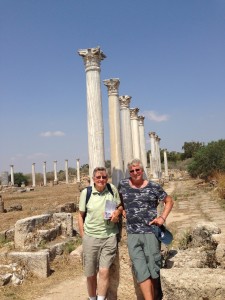
The Idiot and MedTrekker Michael Knipe visit Salamis, an ancient Greek city state with ruins dating to the Late Bronze Age III. (Photo: Liz Chapin)
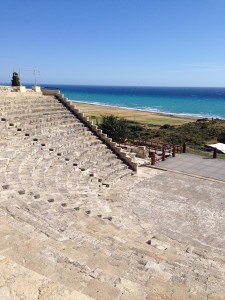
The Idiot spent a few mediative hours in Kourion, which dates to the Hellenistic and early Byzantine period.

The MedTrek went through the Paphos Archaeological Park, which has been a UNESCO World Heritage Site since 1980.

The Idiot and MedTrekker Chris Elliott pass the 16th century Kyrenia/Girne castle built by the Venetians over an earlier Crusader fort. (Photo: Michael de Glanville)
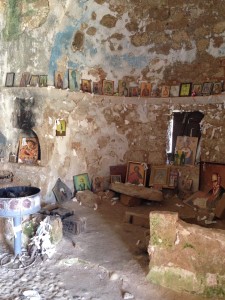
The icon-filled Agios Thyrsos Greek Orthodox chapel was constructed in the late 16th century.
But it’s the current era, since independence from Britain in 1960 to the present, that really differentiates Cyprus from other islands.
Cyprus is partitioned into two states — the Greek Cypriot Republic of Cyprus in the south with about 60 percent of the land and the Turkish Republic of Northern Cyprus — and the result is a schizophrenic divide that is policed, patrolled and maintained by the United Nations (which arrived in 1964 and maintains a peacekeeping force to monitor a 180-kilometer, or 112-mile, buffer zone that divides the country), Britain (which kept two Sovereign Base Areas after independence), Turkey (which invaded, or intervened, in 1974 and created the Turkish Republic of Northern Cyprus in 1983), the Greek Cypriot National Guard and other countries and institutions with a military or more-than-just-diplomatic presence (Russia is currently trying to gain entry).
The result is two languages (Turkish in the north, Greek in the south), two currencies (Turkish lira in the north, the euro in the south), two religions (Islam in the north, Greek Orthodox in the south) and two of almost everything else. Although almost everyone agrees that the status quo is unacceptable, peace generally reigns and there’s no way to predict how Cyprus will evolve.
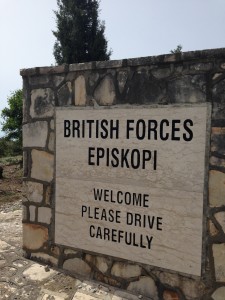
The British have maintained Sovereign Base Areas, which are considered English soil, since 1960.
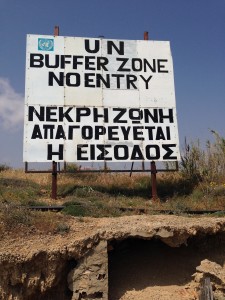
The UN has helped keep the peace in Cyprus since 1964.
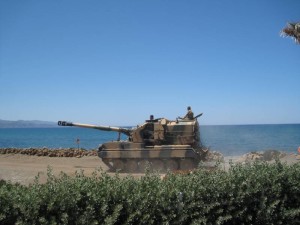
Turkish forces have been in Northern Cyprus since they invaded, or intervened, in 1974. (Photo: Michael de Glanville)
This made for interesting conversations and observations for The Idiot and other MedTrekkers as they circumnavigated the island country.
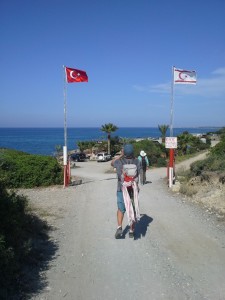
MedTrekking in the Turkish Republic of Northern Cyprus (which is recognized only by Turkey) where Turkish and TRNC flags fly next to each other. (Photo: Liz Chapin)

MedTrekking in the Turkish Republic of Northern Cyprus involves casual interaction with Turkish troops.
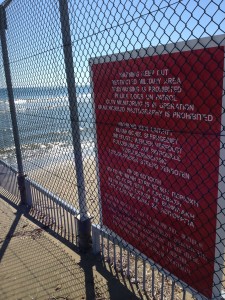
The Idiot was briefly detained by British Forces when he MedTrekked into the Sovereign Base Area at Akrotiri.
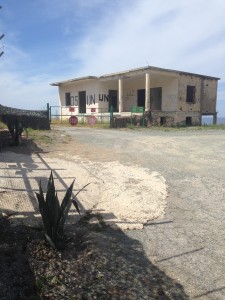
The Idiot approaches an abandoned United Nations outpost in the Republic of Cyprus, which became a member of the European Union in 2004.
Next week: The Idiot’s favorite swimming holes du jour in Cyprus.

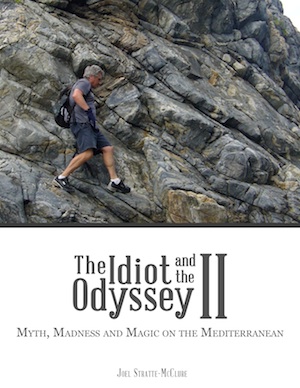


 Follow
Follow